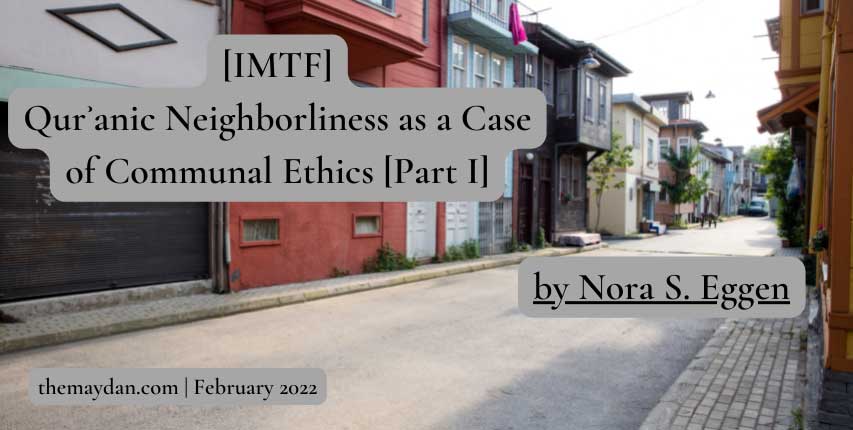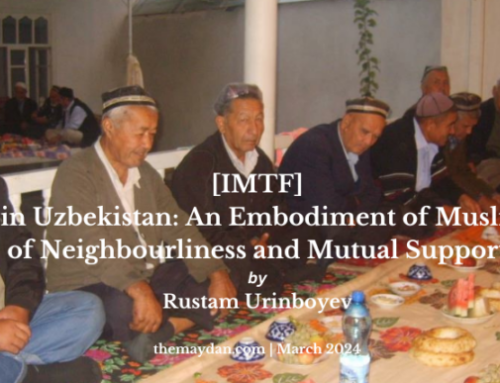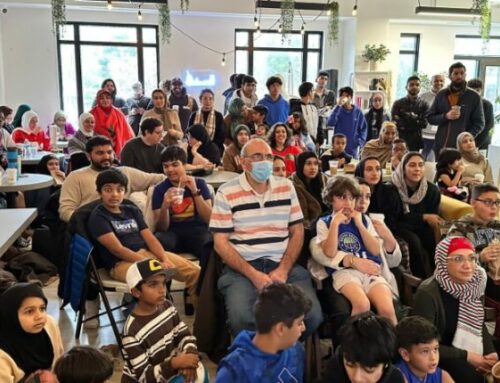
Qurʾanic Neighborliness as a Case of Communal Ethics [Part I]
The neighborhood may be conceived as an intermediate space, a location between the private and the public. Here, an individual extends the immediate and private space of human interaction. The people populating this space are not necessarily part of one’s inner circle, but neither do they belong to the general public. One’s physical neighbors are likely not selected, and although their geographical vicinity may speak to social, cultural, or material compatibility, even that is not guaranteed. You might be on friendly terms with your neighbors, but then again, you might not. In some neighborhoods, newcomers are quickly integrated into established social structures; in other neighborhoods years go by without anyone greeting anyone. In times of conflict and war, the neighbor may become an ally or an enemy. Through all this, the neighbor remains a discrete category, different from family and friends, from colleagues and associates. Despite a separating door, the neighbor is a (relative) constant in one’s life in a different way than people crossing paths in the public space. Whether behind rarely opened doors or behind doors always open to a visitor, the realization that the neighbor is there represents a distinct individual relation interwoven with other neighborly relations. The neighborhood is the communal space where these relations are manifested. As such it calls for a distinct ethics, a communal ethics in the sense of a moral responsibility to engage in communal and community building processes.
“What guidance does the Qur’an offer for a communal ethics of the neighborhood? We must first ask: Who is the Qur’anic ‘neighbor’? What do we, according to the Qur’an, owe to the neighbor, and what are the boundaries of the neighborhood relation?”
What guidance does the Qur’an offer for a communal ethics of the neighborhood? We must first ask: Who is the Qur’anic “neighbor”? What do we, according to the Qur’an, owe to the neighbor, and what are the boundaries of the neighborhood relation?
I start the investigation of these questions with the Qur’anic notion al-jār. This noun occurs only three times throughout the text, and twice in the same verse, Qur’an 4:36. In this verse it is conventionally translated as “neighbor.” Lexicographical and exegetical literature attests to the semi-technical meaning of the term as “someone living close by.” In the third occurrence, Qur’an 8:48, translators offer different translations for “jār,” including “neighbor,” but often more general notions like “being right beside,” “protector,” “supporter,” and “defender.” Here, we will regularly use the translation “neighbor,” bearing in mind its wider connotations.
According to lexicographers, the Arabic root of the term jār (j-w-r) denotes a movement — “to incline towards” or “to deviate from” — as well as a general sense of proximity and assistance. The noun jār holds the contextually dependent double meaning of both someone asking for help and someone extending help. As an inherently reciprocal noun, a person is a neighbor (jār) to someone only if that other person is also her “neighbor.” Nevertheless, the two parties may of course respond in different ways to their joint status as “neighbors.” Metaphorical usages include meanings such as a business partner, ally, a wife to a husband and a husband to a wife, all evoking positive expectations. However, lexicographers acknowledge possible negative connotations of the term as well, and they report that it may also be used to describe a hypocrite or an envious person. Thus, we notice a tension and a certain semantic ambiguity in the very notion, both in terms of who the neighbor is and what a person’s status as neighbor entails.
In addition to the polysemantic potential in the Arabic term for neighbor (jār), other words related to it in either root or meaning enrich the discussion of a Qur’anic ethics of the neighbor. In particular, the verbs for “seeking protection” (istajāra) and “providing protection” (ajāra) are used in Qur’an 9:6, while the verb for “remaining close to” (jāwara) in found in Qur’an 33:60, indicating that the Qur’anic concept of neighborliness embodies both closeness and mutual protection.. Moreover, both prescriptive and narrative passages contribute to the complexity of the Qur’anic ethics on this subject. In prescriptive passages concerned with normative ethics, neighborliness is associated with goodness. However, in narrative passages in which moral dilemmas are played out, the term for neighbor may also be associated with treacherous behavior. The question is whether the latter qualifies as neighborliness at all, in the Qur’anic, ethical sense.
The Qurʾanic prescriptive ethics of the neighbor found in Qur’an 4:36 is framed by a general command to worship God, treat others well, and exercise benevolence towards specified categories of persons entitled to one’s kindness and consideration
The Qurʾanic prescriptive ethics of the neighbor found in Qur’an 4:36 is framed by a general command to worship God, treat others well, and exercise benevolence towards specified categories of persons entitled to one’s kindness and consideration:
وَاعْبُدُوا اللَّهَ وَلَا تُشْرِكُوا بِهِ شَيْئًا ۖ وَبِالْوَالِدَيْنِ إِحْسَانًا وَبِذِي الْقُرْبَىٰ وَالْيَتَامَىٰ وَالْمَسَاكِينِ وَالْجَارِ ذِي الْقُرْبَىٰ وَالْجَارِ الْجُنُبِ وَالصَّاحِبِ بِالْجَنْبِ وَابْنِ السَّبِيلِ وَمَا مَلَكَتْ أَيْمَانُكُمْ ۗ إِنَّ اللَّهَ لَا يُحِبُّ مَنْ كَانَ مُخْتَالًا فَخُورًا
Worship God, and ascribe not partners unto Him. And be virtuous (iḥsān) toward parents and kinsfolk, toward orphans and the indigent, toward the neighbor who is close/related (al-jāri dhī l-qurbā) and the neighbor who is nearby/not related (wa’l-jāri l-junubi), toward the companion at your side and the traveler, and toward those whom your right hands possess. Truly God loves not one who is a vainglorious boaster.[1]
There are several similar lists of those entitled to special benevolence in the Qur’an, in which different types of relationships are morally defined by one party being instructed to grant a charitable act to another party belonging to a certain category. The modes of charity may involve material or immaterial support, or both. Eight Qur’anic beneficiary lists include altogether 15 categories of charity beneficiaries, which may be further systematized into four supercategories: 1) kin relations without necessarily specific needs[2]; 2) individuals in need of protection or aid because of personal situations[3]; 3) individuals who by virtue of their function merit a form of compensation[4]; and finally 4) those whose entitlement is neither based on kindred responsibility, nor on any specific need or merit, but on vicinity in some form.
Included in the last supercategory are the neighbor (jār) and the companion at your side (al-ṣāḥib bi’l-janb), mentioned in Qur’an 4:36. These persons are not by default disadvantaged, and the relation between the benefactor and the beneficiary is in these cases neither necessarily innate, nor necessarily non-symmetrical. What they have in common is physical, social, or moral proximity, as well as the fact that these relations are, in principle, if not in any given social situation, voluntary, temporary, and balanced.
Given these various uses of the term jār, the first question we should ask is: Who should be defined as a “neighbor”? Commentators consider different suggestions, ranging from the literal next-door neighbor to residents of 40 houses in all directions as stipulated in a ḥadīth (mentioned by Mohammad Hashim Kamali in a previous contribution to this roundtable), or residents in shouting distance, or, as some would have it, living in the same town. According to many commentators, however, the defining element of the neighborhood is physical vicinity.
Moreover, the beneficiary category of the neighbor is further divided into two subcategories: the neighbor who is close/related (al-jāri dhī l-qurbā) and the neighbor who is nearby/not related (wa’l-jāri l-junubi). Both modifiers of the term “neighbor” here denote “closeness,” so to whom do the two subcategories refer? There are no Qur’anic clues to the meaning of this differentiated concept, nor does the prophetic tradition offer any decisive explanation. The two expressions do not occur in the literature other than in comments on this verse, and the conundrum of the semantic similarity of the two terms was a major concern in the commentary literature. Some commentators suggest that the reference here is to neighbors who are blood relatives versus those who are not, while others understand the terms to mean neighbors who are geographically close and those who are more distant.[5] Yet other commentators discuss the possibility of a communal interpretation in the sense of a shared versus unshared religious affiliation. In this sense, the neighborhood, or community, may thus be conceptualized in concentric circles with physical, genealogical, or ideological distance as the constituent element of each circle.
…iḥsān, with its semantic content related to both “beauty” and “good,” remains a non-operationalized, versatile, and situational ethical notion encompassing both material and immaterial kindness and beneficence.
Furthermore, what does the command to treat all of these persons with iḥsān in Qur’an 4:36 entail? Immediately preceding this verse is a series of instructions concerning financial matters and marital life (Q. 4:2–35), and immediately following the command to iḥsān is a warning against miserliness and a call to spend from God’s gifts (Q. 4:37–40). This may suggest that iḥsān here should be understood in material terms. However, iḥsān, with its semantic content related to both “beauty” and “good,” remains a non-operationalized, versatile, and situational ethical notion encompassing both material and immaterial kindness and beneficence.
Compared to the more detailed prescriptions surrounding Qurʾān 4:36, the verse itself presents a general ethical admonition. It is not addressed to any specific audience, and since the neighbor (jār) is an inherently reciprocal notion, it follows that the Qur’anic admonition to treat the neighbor well is part of a universal Qur’anic ethic. Neither of the two types of neighbor found in Qur’an 4:36 are by default needy, nor are they in an asymmetrical power relationship, but they are still entitled to good treatment. Their status as neighbor is situational and conditioned by circumstance, and so is the charitable mode in which they are to be treated. Moreover, the differentiated concept of neighbor here may indicate that social relations should be organized according to concentric circles of commitment and responsibility. According to this understanding, the differentiated conception of the Qur’anic neighbor reminds the reader of the responsibility to prioritize immediate and proximate individuals, without, however, denying or neglecting the responsibility towards the distant.
In Qur’an 9:6, a slightly different picture is drawn:
وَإِنْ أَحَدٌ مِّنَ الْمُشْرِكِينَ اسْتَجَارَكَ فَأَجِرْهُ حَتَّى يَسْمَعَ كَلاَمَ اللّهِ ثُمَّ أَبْلِغْهُ مَأْمَنَهُ ذَلِكَ بِأَنَّهُمْ قَوْمٌ لاَّ يَعْلَمُونَ
And if any of the idolators seek asylum with thee, grant him asylum until he hears the Word of God. Then convey him to his place of safety. That is because they are a people who know not.
…the differentiated conception of the Qur’anic neighbor reminds the reader of the responsibility to prioritize immediate and proximate individuals, without, however, denying or neglecting the responsibility towards the distant.
In simple terms, the verse prescribes granting protection to someone asking for it: if one party, from among an opposing group, seeks protection (istajāra), then the other party, the Qur’anic addressee is instructed to provide that protection (ajāra), whereupon the first party should be conferred to a safe space (maʾmana).
Similar to Qur’an 4:36, this passage is prescriptive in form, but the literary context is more particular. In this context, the jārhood (or neighbor-like status) of the asylum-seeking idolater, that is, the right to protection that this status entailed, was understood by commentators as an individual, situational, and conditional right, rather than a universal claim. The rationale for the obligation of protection is that the idolater should be given a chance to hear the Word of God. Commentators also hold that this passage refers historically to an incident where the Prophet’s daughter, Zaynab, offered her husband public protection (ijāra) while he was still an unbeliever, in accordance with an age-old custom sanctioned by the Prophet. The verse, along with its literary, thematic, and historical context, raises a number of issues discussed in commentary as well as in legal literature. If we take the proposed historical context into consideration, it is interesting to note that the verse seems to advocate communal solidarity facilitated through the agency of individuals, both men and women, given the example above.
Of particular relevance for contemplating a Qur’anic ethics of the neighborhood, however, is the way the two verbs, “seeking protection” (istajāra) and “providing protection” (ajāra), link the noun jār morphosemantically to the technical term for protection or asylum (ijāra). The aspect of protection in the term jār/neighbor and the aspect of protection in the term ijāra/asylum creates a conceptual connection between the two social spaces. Thus, the normative ethical impulse toward the neighbor extends to a situation of conflict, and communal solidarity goes beyond the physical, genealogical, or ideological distance referred to above.
Of particular relevance for contemplating a Qur’anic ethics of the neighborhood, however, is the way the two verbs, “seeking protection” (istajāra) and “providing protection” (ajāra), link the noun jār morphosemantically to the technical term for protection or asylum (ijāra).
Despite the differences in scope, the ethical impulse and prescriptive tone is similar in the two passages: neighborliness in the form of help, protection, or good treatment is an obligation impressed on the reader. A standard is set: an ideal ethos of helping the neighbor – whoever and whatever that means in more practical terms. The Qur’anicly-differentiated neighborhood may be conceptualized as the immediate physical or social community, as well as a space reaching beyond the geographical boundaries of a traditional neighborhood. In this way, Qur’anic neighborhood ethics may possibly be understood as speaking to discourses of global justice or even environmental justice. There are, however, other issues that complicate the application of this concept in a Qur’anic communal ethics. In addition to the semantic and normative ambiguities I have explored in this blog post, the Qur’anic concept of the neighbor (jār) brings the precarious potential of the neighborliness (or “jārness”) to the fore. This I will address in my next post.
Nora S. Eggen holds a PhD in Arabic and Islamic Studies and is currently affiliated with the University of Oslo, Norway. Her research interests include premodern intellectual history, Qurʾanic studies, translation studies, ethics, and the history of Islamic Studies in the Scandinavian countries. Among her recent publications are: “The Ambiguous jār: Towards a Qurʾanic Neighborhood Ethics.” In The Ambiguous Figure of the Neighbor in Jewish, Christian, and Islamic Texts and Receptions (Routledge, 2021); “Trust, trusting and trustworthiness in ethical discourse,“ Journal of Islamic Ethics (2021); “al-Qadi ʿIyad’s Defence of the Prophet and of scholarly tradition: al-Shifāʾ,” in Freedom of Expression in Islam: Challenging Apostasy and Blasphemy Laws (Tauris, 2021); “On the Periphery: Translations of the Qurʾān in Sweden, Denmark and Norway.” In Routledge Handbook of Arabic Translation (Routledge, 2019).
*This blog post builds on a recently published article:
Nora S. Eggen. “The Ambiguous jār: Towards a Qurʾanic Neighborhood Ethics.” In The Ambiguous Figure of the Neighbor in Jewish, Christian, and Islamic Texts and Receptions, ed. Marianne Bjelland Kartzow, 126–150. London: Routledge, 2022.
[1] I have utilized The Study Quran, HarperOne, 2015 for all translations of Qur’anic verses in this text.
[2] Q. 2:83; 2:177; 2:215; 4.36; 16:90; 17:26; 30:38
[3] Q. 2:83; 2:177; 2:215; 4:36; 9:60; 17:26; 30:38
[4] Q. 9:60
[5] Accordingly, for instance in The Study Qurʾān the expression is translated “the neighbor who is of kin and the neighbor who is not of kin,” while others opt for “neighbours near and far” (transl. Abdel Haleem 2004).





